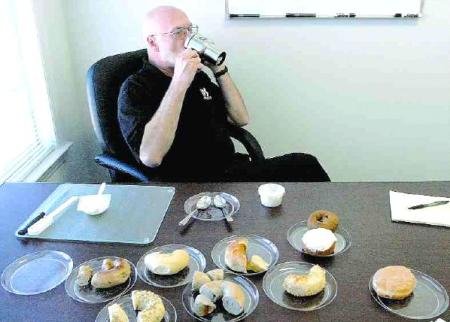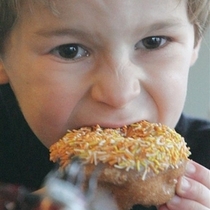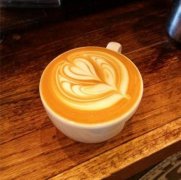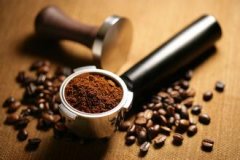Scientists develop caffeine doughnuts to eat exciting without bitterness.

Scientist Bohan Ron developed caffeine doughnuts

Scientist Bohan Ron holds a doughnut with coffee sugar coating in his hand.

This kind of doughnut tastes exciting.
According to foreign media reports on January 30, a molecular scientist who also works as a coffee shop owner has developed a way to add caffeine to baked goods that do not have the natural bitterness of coffee itself.
Robert Bohan Ron, who developed the caffeinated food, said: "if people want both milk and coffee, there is an opportunity." Although he makes a variety of coffee, Bohan Ron can easily add 100 milligrams of caffeine to doughnuts and bagels to make so-called "intoxicated doughnuts" and "intoxicated bagels" and plans to supply them to the market.
Bohan Ron owns his own coffee shop in Durham called sucking Coffee Teahouse, which currently does not sell this intoxicating food. He is applying for a patent and discussing cooperation with some food companies, but no results have yet been reached. As waist size and anxiety have been tested around the world, some observers doubt the wisdom of combining caffeine and calories, the two key elements of these problems.
"I don't think it's good," said Barry Bob King, a nutritionist at the University of North Carolina. "in many ways, we're making a super caffeine generation. They don't get enough sleep, and they consume a lot of caffeine to stay awake, but they don't understand that it's bad for their health. It's like adding vitamin C to candy, saying you get vitamin C from candy. "
Bob King, who studies the health effects of caffeine, says consuming more than 300-400 milligrams of caffeine a day can lead to heart problems and other side effects. There are 30-55 milligrams of caffeine in 12 ounces of carbonated drinks.
Bohan Ron, now 55, has said he has known about these risks since he was 8 years old, and has repeatedly stressed the need for moderation. "you can't overdo anything," he said. But he points out that caffeine can make people more alert. He said someone needed more caffeine, and a customer at his coffee shop ordered eight cups of high-caffeinated espresso at a time.
"sometimes I want juice instead of coffee in the morning, but I still have some caffeine, so I like caffeine bagels or caffeine donuts, which would be absolutely good," said Harris, a guest at the coffee shop.
Bohan Ron says he had the idea of developing caffeine baked goods six years ago. "I sat in front of a glass of milk and a doughnut, and I had to put them together one morning," he said. So he started making caffeine baked goods. He first added raw caffeine to the doughnuts. "they are so bitter, they taste terrible, and the caffeine is so bitter that you want to throw up," he said. " So he began to think about turning caffeine into small flour-like particles, eliminating its bitterness and making it granulated, and he coated it with vegetable oil.
Bohan Ron has a doctorate in molecular biology from the University of Colorado and a doctorate from Belem School of Medicine, and has run a small company. The company uses hypersensitivity tests to detect early pregnancy, disease infections and other conditions. But he thinks his caffeine cake is another breakthrough. "some people get the pleasure of caffeine from foods other than coffee, such as carbonated drinks, chocolate and other things," he said. " Therefore, eating cakes will also become a choice.
Important Notice :
前街咖啡 FrontStreet Coffee has moved to new addredd:
FrontStreet Coffee Address: 315,Donghua East Road,GuangZhou
Tel:020 38364473
- Prev

The basic knowledge of coffee in the main producing areas of coffee all over the world
1 South America [Colombia (Colombia)] is the second largest coffee producer in the world, accounting for about 12% of the world's annual output, which is much lower than that of Brazil, but most of them are high-quality mountain-washed beans. Central Colombia is divided into valleys by three north-south longitudinal mountains, of which the central and eastern mountains are the main coffee producing areas. Coffee here
- Next

The long History of Coffee Culture
With the first coffee bean picked, the first roasting test, the first grinding, the first blending and the mellow smell of the first cup of hot coffee, the legend of coffee cultivation and coffee culture spreading on our small planet has become one of the greatest and most romantic stories in history. Legends about the origin of coffee vary, but mostly because of its absurdity
Related
- Beginners will see the "Coffee pull flower" guide!
- What is the difference between ice blog purified milk and ordinary milk coffee?
- Why is the Philippines the largest producer of crops in Liberia?
- For coffee extraction, should the fine powder be retained?
- How does extracted espresso fill pressed powder? How much strength does it take to press the powder?
- How to make jasmine cold extract coffee? Is the jasmine + latte good?
- Will this little toy really make the coffee taste better? How does Lily Drip affect coffee extraction?
- Will the action of slapping the filter cup also affect coffee extraction?
- What's the difference between powder-to-water ratio and powder-to-liquid ratio?
- What is the Ethiopian local species? What does it have to do with Heirloom native species?

